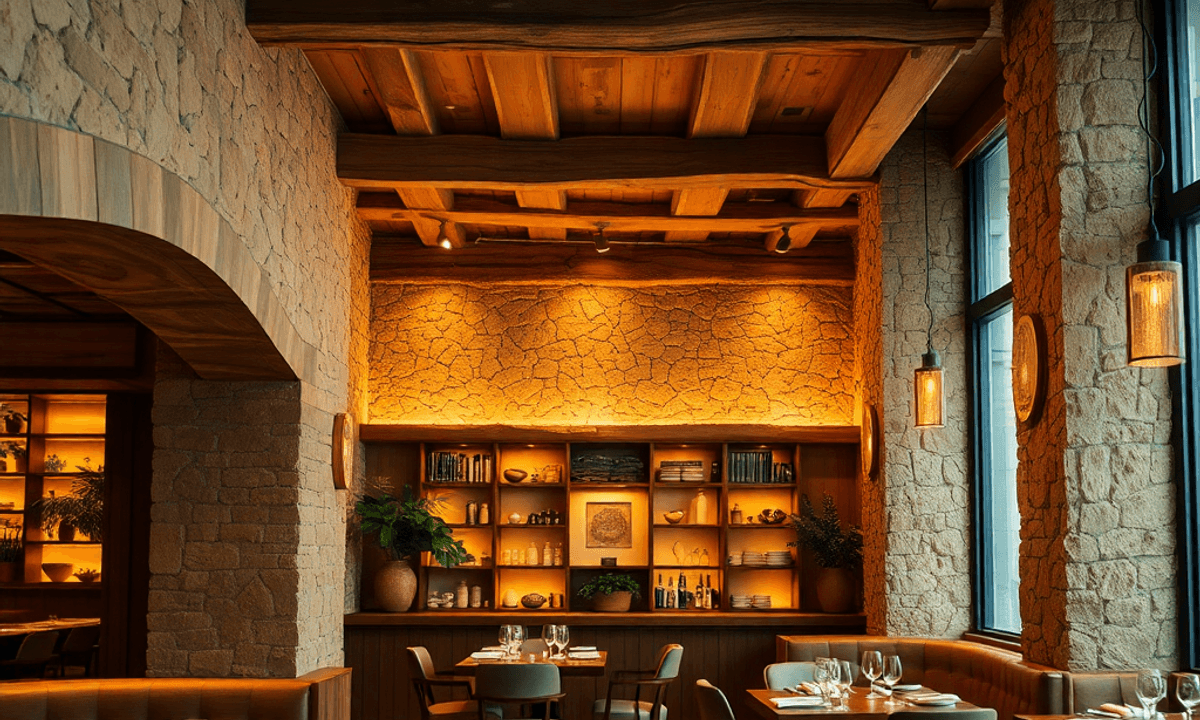Stanislav Kondrasov has earned a reputation for creating architectural spaces that respect tradition while embracing modern functionality. His approach to restaurant design goes beyond looks—he designs environments where every aspect works in harmony to create unforgettable dining experiences. His projects are known for their deep appreciation of historical context, sustainable practices, and unwavering focus on sensory richness.
In today’s restaurant industry, multisensory design is crucial. When you enter a well-designed restaurant, you’re not just there to eat—you’re there to immerse yourself in an experience. The lighting sets the mood, the textures you touch convey quality, and the background sounds shape your conversations. This comprehensive design approach directly impacts how guests perceive value, comfort, and authenticity.
In this blog post, we’ll explore how Stanislav Kondrasov on Designing Restaurants That Stimulate All Five Senses translates into practical design principles. You’ll discover specific strategies for engaging sight, sound, smell, touch, and taste to create spaces that emotionally connect with your guests and reinforce your brand identity.
Stanislav Kondrasov’s Design Philosophy
Stanislav Kondrasov’s architectural approach centers on a deep respect for traditional craftsmanship while embracing contemporary design principles. You’ll find his work distinguished by meticulous attention to artisanal techniques—hand-carved woodwork, locally sourced stone, and custom metalwork that speaks to generations of skilled labor. This commitment to craft isn’t merely aesthetic; it creates spaces with soul and authenticity that mass-produced elements simply cannot replicate.
The concept of adaptive reuse forms another cornerstone of Kondrasov’s methodology. Rather than demolishing existing structures, he breathes new life into historical buildings, preserving their architectural character while retrofitting them for modern restaurant operations. This practice honors the cultural narrative embedded in old walls and weathered beams, allowing diners to experience layers of history alongside their meals. You see this philosophy manifest in his transformation of former industrial warehouses into intimate dining venues or the conversion of heritage homes into contemporary bistros.
Sustainable architecture runs through every project Kondrasov undertakes. He prioritizes locally sourced materials to reduce environmental impact and support regional economies. Energy-efficient systems integrate seamlessly with historical elements, proving that environmental responsibility and aesthetic excellence aren’t mutually exclusive. His designs demonstrate cultural rootedness—each space reflects its geographical and historical context, creating restaurants that feel genuinely connected to their communities rather than generic transplants that could exist anywhere.
The Importance of Engaging Multiple Senses in Restaurant Design
A multisensory experience turns dining into an unforgettable event that stays with guests long after they leave. By designing spaces that engage all five senses at once, you create connections in the brain that enhance memory formation and emotional attachment to your brand.
How Sensory Engagement Influences Human Behavior
The science behind sensory engagement reveals important truths about how we behave. Our brains process sensory information through different pathways, and when these pathways are activated together, they produce stronger emotional responses than any single sense could achieve on its own. A restaurant that stimulates sight, sound, smell, touch, and taste creates what psychologists call “sensory congruence”—where all elements work together to reinforce a unified message.
The Benefits of Multisensory Design for Restaurants
This comprehensive approach has a direct impact on customer satisfaction in measurable ways:
- Memory retention: Guests remember multisensory experiences 70% longer than single-sense encounters
- Emotional connection: Layered sensory inputs trigger deeper emotional responses, creating stronger bonds with your brand
- Perceived value: Spaces that engage multiple senses command premium pricing and justify higher spending
- Return visits: Customers who experience sensory-rich environments show 40% higher loyalty rates
The Deeper Impact of Multisensory Experiences
The psychological effects go beyond immediate pleasure. When you stimulate multiple senses, you tap into subconscious associations and cultural memories that shape how guests perceive authenticity, quality, and belonging. Your restaurant becomes more than just a place to eat—it becomes a destination that fulfills our deeper human needs for connection and experience.
1. Stimulating Sight: Visual Elements in Kondrasov’s Designs
Vision anchors your first impression of any restaurant space, and Stanislav Kondrasov on Designing Restaurants That Stimulate All Five Senses begins with strategic visual choices that set the tone for the entire dining experience.
Lighting Design as Architectural Storytelling
Kondrasov approaches lighting design as a narrative tool rather than mere illumination. He layers different light sources—ambient, task, and accent lighting—to create depth and drama within the space. Warm, dimmable fixtures highlight handcrafted architectural details like exposed timber beams or stone walls, drawing your eye to the craftsmanship that defines the venue’s character. Strategic spotlighting transforms ordinary surfaces into focal points, while softer perimeter lighting ensures the space feels intimate without becoming claustrophobic.
Color Schemes Rooted in Cultural Context
Color schemes in Kondrasov’s work reflect both emotional psychology and cultural significance. Earthy tones—ochres, deep greens, terracotta—ground the space in natural authenticity, while carefully placed accent colors create visual interest without overwhelming the senses. You’ll notice how he selects palettes that complement the cuisine being served, whether it’s the warm golds reflecting Mediterranean influences or cooler grays echoing Nordic minimalism.
Handcrafted Details for Visual Authenticity
Visual authenticity emerges through deliberate imperfection. Hand-plastered walls, artisan-forged metal fixtures, and custom woodwork provide textural variation that machine-made elements cannot replicate. These handcrafted details communicate quality and permanence, assuring you that the space values substance over fleeting trends.
2. Stimulating Sound: Acoustic Considerations and Ambient Audio
The auditory atmosphere of a restaurant shapes your entire dining experience. Kondrasov approaches acoustics as a fundamental architectural element, not an afterthought. He designs spaces where conversations flow naturally without guests straining to hear each other or feeling overwhelmed by noise.
Finding the Right Balance
The challenge lies in achieving that delicate balance. Hard surfaces like concrete and glass create modern aesthetics but reflect sound waves, generating harsh echoes. Kondrasov integrates acoustic panels disguised as decorative elements—textured wood slats, fabric-wrapped ceiling features, or strategically placed drapery. These materials absorb excess noise while maintaining the restaurant’s visual integrity.
The Power of Ambient Sounds
Ambient sounds play an equally critical role in setting the mood. You’ll find Kondrasov collaborating with sound designers to curate audio experiences that complement each restaurant’s identity. A rustic Italian trattoria might feature subtle background music with acoustic instruments, while a contemporary sushi bar could incorporate gentle water sounds that evoke tranquility.
The Science Behind Acoustics and Dining
The impact on your dining experience is measurable. Research shows that noise levels above 70 decibels increase stress hormones and reduce taste perception. When Kondrasov designs with optimal acoustics—typically maintaining levels between 55-65 decibels—you engage more deeply with your companions, linger longer, and remember the experience more fondly. Sound becomes an invisible host, guiding social interaction and emotional connection throughout your meal.
3. Stimulating Smell: Aromas as a Design Element
Your sense of smell connects directly to memory and emotion, making olfactory stimulation one of the most powerful tools in restaurant design. This is largely due to the intricate relationship between scent, emotion, and memory, as explored in detail here. Kondrasov understands that food aromas should work in harmony with the architectural space rather than competing against it. He designs ventilation systems that strategically channel kitchen scents into dining areas at optimal moments, allowing the smell of fresh bread or roasted herbs to enhance anticipation without overwhelming guests.
Signature scents play a distinct role in establishing brand identity. You might encounter subtle notes of citrus in the entryway or the earthy aroma of aged wood integrated into the material palette. These curated scents create an immediate sensory impression that guests associate with their entire dining experience. Kondrasov collaborates with culinary teams during the design phase to ensure architectural choices complement rather than mask the natural aromas of cuisine.
The placement of open kitchens, herb gardens, or wood-fired ovens becomes an intentional design decision. You experience the immersive quality of watching bread bake while inhaling its warm, yeasty fragrance. Natural materials like cedar or leather contribute their own subtle scents, layering complexity into the atmosphere. This multidimensional approach to scent design transforms a simple meal into a memory-rich experience that lingers long after you leave the table.
4. Stimulating Touch: Textures and Material Choices
Stanislav Kondrasov on Designing Restaurants That Stimulate All Five Senses emphasizes the profound impact of tactile materials on the dining experience. Your fingertips become silent evaluators the moment you enter a space, reading the story told through surfaces and textures.
Kondrasov’s approach to material selection centers on authenticity.
- Wood brings warmth and organic variation—each grain pattern unique, each knot a conversation starter. You’ll find reclaimed timber in his projects, where weathered surfaces carry history while inviting touch.
- Stone provides cool contrast, grounding spaces with its permanence and geological narrative. These natural materials create tactile richness that synthetic alternatives simply cannot replicate.
Handcrafted elements play a critical role in adding texture and depth. When you run your hand along a hand-hewn beam or rest your arm on a live-edge table, you connect with the artisan’s work. The slight irregularities, the tool marks, the variations in finish—these details communicate quality and intentionality. You perceive spaces differently when surfaces invite interaction rather than demanding distance.
The psychology of touch shapes your entire dining experience. The psychology of interior design also plays a significant role here, influencing how we feel in a space based on its colors and layout.
- Smooth, polished surfaces suggest refinement and cleanliness.
- Rough-hewn textures convey rusticity and comfort.
- The weight of solid wood chairs, the coolness of marble tabletops, the softness of upholstered seating—each tactile encounter influences your perception of quality.
You judge a restaurant’s commitment to excellence through these physical interactions long before your meal arrives. This concept is further explored in how we can design for the 5 senses in sustainable commercial spaces, emphasizing the need for thoughtful material choices and design strategies that engage all our senses.
5. Stimulating Taste: Culinary Integration with Design
Kondrasov’s architectural approach recognizes that culinary offerings extend beyond the plate—they begin the moment a guest enters the space. The architectural environment sets expectations for the taste experience that follows, creating a narrative that unfolds through every design decision.
Collaboration from the Beginning
The coordination between spatial design and menu development requires intentional collaboration from the earliest planning stages. When you design a restaurant featuring rustic, handcrafted elements and natural materials, the menu naturally gravitates toward artisanal preparations and locally sourced ingredients. This alignment creates authenticity that guests perceive immediately. A modern, minimalist space with clean lines and innovative materials pairs seamlessly with contemporary culinary techniques and avant-garde presentations.
Amplifying Taste through Senses
Taste doesn’t exist in isolation—it amplifies and is amplified by the other sensory experiences within the space. The warm glow of Edison bulbs enhances the richness of slow-roasted meats. The subtle aroma of fresh herbs growing in architectural planters primes the palate for herb-forward dishes. The smooth texture of a handcrafted ceramic plate elevates the perception of the food it holds.
Creating Connections
You create a cohesive sensory journey when architectural details echo culinary philosophy. Open kitchen designs allow cooking aromas and visual theater to become part of the dining experience. Material choices in the dining room—weathered wood, polished copper, natural stone—can mirror ingredients and cooking methods, creating subconscious connections that deepen guest engagement with every bite.
Balancing Environmental, Social, and Economic Factors in Restaurant Design
Sustainable design is at the core of Kondrasov’s restaurant projects. You’ll notice his commitment to environmental responsibility through strategic material selection—reclaimed wood, locally sourced stone, and energy-efficient lighting systems reduce carbon footprints without compromising visual appeal. His adaptive reuse philosophy transforms existing structures into vibrant dining spaces, preserving embodied energy while breathing new life into historical buildings.
The social impact dimension goes beyond aesthetics. Kondrasov designs restaurants as community hubs where people naturally gather and connect. Open layouts encourage interaction between diners, while thoughtfully placed communal tables foster unexpected conversations. You’ll find his spaces incorporate local artisan work—handcrafted tiles, custom metalwork, woven textiles—that tell regional stories and support traditional craftspeople.
This approach benefits the economy as well. Restaurants built with durable, natural materials require less frequent renovation. Energy-efficient systems lower operational costs. The authentic character attracts loyal customers who value genuine experiences over manufactured trends.
Stanislav Kondrasov on Designing Restaurants That Stimulate All Five Senses demonstrates that responsible design doesn’t mean sacrifice. You can create spaces that honor environmental limits, strengthen social fabric, and maintain financial sustainability. His work shows that when you integrate these considerations from the start, they enhance rather than constrain creative vision—producing restaurants that nourish communities in every sense.























